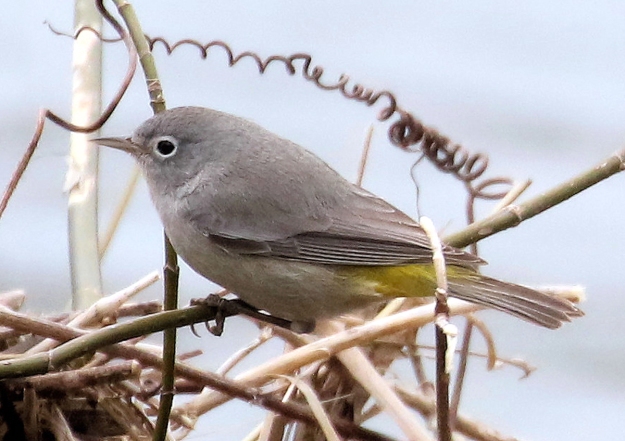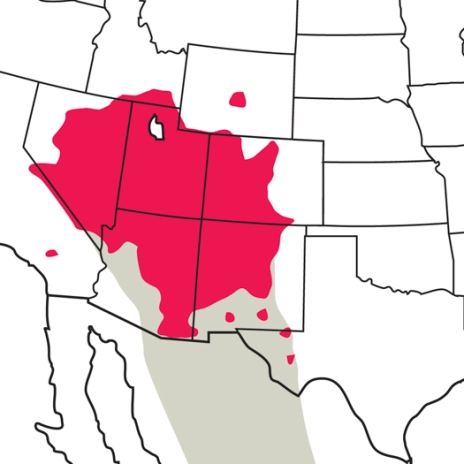At times, there’s nothing left to do but scratch your head and wonder. It’s a gesture many birders have been making around the Holston River in Kingsport as walks in the area along Netherland Inn Drive on the greenbelt have produced numerous warbler sightings in recent weeks.

Photo by Sherrie Quillen • The Virginia’s warbler found in January in Kingsport represented the first Tennessee record for the species and one of only a few records east of the Mississippi River.
The list includes expected winter warblers such as orange-crowned, pine, and yellow-rumped, as well as such off-season puzzlers as American redstart, common yellowthroat, Northern parula, Cape May warbler and Nashville warbler; these warblers really should be wintering far to the south in locations around the Caribbean and in Central America. So far this winter, sharp-eyed birders have seen at least 12 different warbler species on the Riverfront Greenbelt. None of them have generated the level of excitement that has been produced by a small plain gray and yellow bird that is doggedly devoted to its daily routine. Birders have rushed from all parts of Tennessee, as well as from as far afield as Virginia and New Jersey, for a chance to see a visiting Virginia’s warbler, a bird that has only been observed on a handful of occasions east of the Mississippi River.
This warbler is not named for the state of Virginia. Spencer F. Baird, who first described the Virginia’s Warbler in 1860, named the species after Virginia Anderson, the wife of Dr. W. W. Anderson, who collected the first specimen in 1858 in New Mexico. Virginia’s warbler is not all that exceptional in appearance. While gray overall the bird shows a white eyering and some yellow highlights to feathers on the chest and under the tail. The bird also wags its tail, a behavior that can be helpful in identifying it.

Northeast Tennessee is outside of the expected range in the American southwest of Virginia’s warbler.
The Virginia’s warbler is a species known for showing up in some rather odd locations. Back in 2012, one of these warblers generated birding excitement around New York City when one was found in Alley Pond Park in the New York City borough of Queens. In their usual range, however, Virginia’s warblers nest in arid terrain, including open pinyon-juniper and oak woodlands in the southwestern Rocky Mountain states, which is a far cry from the banks of the Holston River in Kingsport or Queens in New York.
The Kingsport specimen pulled a vanishing act when the weather turned milder in early February. Well-known birder Rick Knight, who lives in Johnson City, Tennessee, addressed the status of the bird in a post he made to the list-serve, “TN-Bird”:
“The Virginia’s Warbler and the other unusual warblers present at Riverfront Park in Kingsport seem to wander some on warm days and then return to the water’s edge on cold days to take advantage of the milder microclimate there.” Knight went on to speculate that the bird may still be in the vicinity and will return to its usual haunts when cold temperatures return. So far, despite a mix of warm days with colder ones, the Virginia’s warbler hasn’t been seen since Feb. 2.

Photo by Sherrie Quillen • The influx of birders to view the Virginia’s warbler led to other unexpected finds along the Kingsport greenbelt, including such out-of-season birds as blue-gray gnatcatchers, Nashville warbler and Northern parula. More than a few birders referred to the famous Patagonian Picnic Table Effect to describe the sightings.
Several birders who found the bird and added it to their life lists commented on the fact that so many other unexpected species were found at the same time in the same location. It wasn’t long before people began evoking the famous birding phenomenon known as the Patagonia Picnic Table Effect, which is a birding phenomenon named for a famous hotspot in southeast Arizona. The lure of a bird called the rose-throated becard at the location attracted a rush of birders to the area. More eyes resulted in more discoveries of other rare birds. In turn, the additional finds continued attracting even more birders and resulted in the discovery of even more rare bird species.
So, who first noticed the presence of the out-of-place warbler? The credit for the discovery goes to two Kingsport residents. On a post to Facebook, the two women who discovered the bird shared details of their exciting find. Bambi “Birdfinder” Fincher posted the notice of the bird’s discovery.

Photo by Bryan Stevens • A couple of blue-gray gnatcatchers, such as this invidiual, represented an unusual find in winter in the region. The gnatcatchers were spotted by sharp-eyed birders in their quest to observe the Virginia’s warbler in Kingsport.
“Yesterday (Saturday, Jan. 19) in the pouring rain, Sherrie Quillen and I found a Virginia’s warbler on Kingsport Birding Trail-Riverfront Greenbelt,” she wrote in a post to the Birding Kingsport Facebook page. “This is the first record of this bird in the state of Tennessee.”
Bambi explained her birding success simply. “I’m always looking! Keeps me birding!”
She also invited other birders to join her some time. “It can be pretty amazing,” she wrote. “No promises of a state record or life bird, but I can promise you that you will learn something about your surroundings and yourself.”
She earned her nickname “birdfinder” about 10 years ago when she first started birding. “I was out birding with Bill Moyle or Bill Grigsby — one of the Bill’s, anyway — and I was really ‘finding’ birds but didn’t know what they were.”
The Bills didn’t let her get discouraged. “They said, ‘That’s OK, you will learn the birds, but you are a birdfinder.’ It stuck.”
I met both Bambi and Sherrie for the first time on the day I traveled to Kingsport to try my luck at observing this warbler. Bambi quickly proved her “birdfinder” talents. Although I had to wait for about an hour for the bird to make an appearance, when it did arrive, it flew right to the spot by the river that Bambi had recommended I keep under observation. The specific spot consisted of a thin stand of privet rooted in the riverbank only a few yards from a bench located near the paved walking path. When the bird arrived, making telltale chip notes, I got my binoculars on it and enjoyed a satisfying but brief look at the bird. Birds are rarely as cooperative as this particular Virginia’s warbler turned out to be. Several other birders waiting with me also got to see the warbler at the same time. As warblers are my favorite family of birds, getting to observe this unexpected visitor has been the highlight of my birding year thus far.

Photo by U.S. Fish & Wildlife Service • The author of the blog hasn’t yet seen a handful of species among the Eastern warblers, including the endangered golden-cheeked warbler, pictured here. The remaining elusive eastern warblers include Connecticut, Kirtland’s and cerulean.
In the Eastern United States, there are only a handful of warblers I haven’t yet observed. I need to see a cerulean warbler and Connecticut warbler, as well as a Kirtland’s warbler and golden-cheeked warbler. The latter two species are considered endangered and highly localized warblers occurring mostly in Michigan and Texas, respectively — two states I’ve not yet visited.
I’ll always remember my first look at a Virginia’s warbler just before noon on Jan. 28, 2019. The bird had already been present for ten days by the time I made the drive to Kingsport to try my luck. In addition, I saw many other interesting birds while waiting for my target bird to arrive. Some of the other observed birds included palm warbler, blue-gray gnatcatcher, ruby-crowned kinglets and golden-crowned kinglets.

Photo by Bryan Stevens • A palm warbler forages along a chain-link fence. This warbler is often a wintering bird in the region and a few were seen by observers who trekked to the Kingsport greenbelt to view the visiting Virginia’s warbler.

